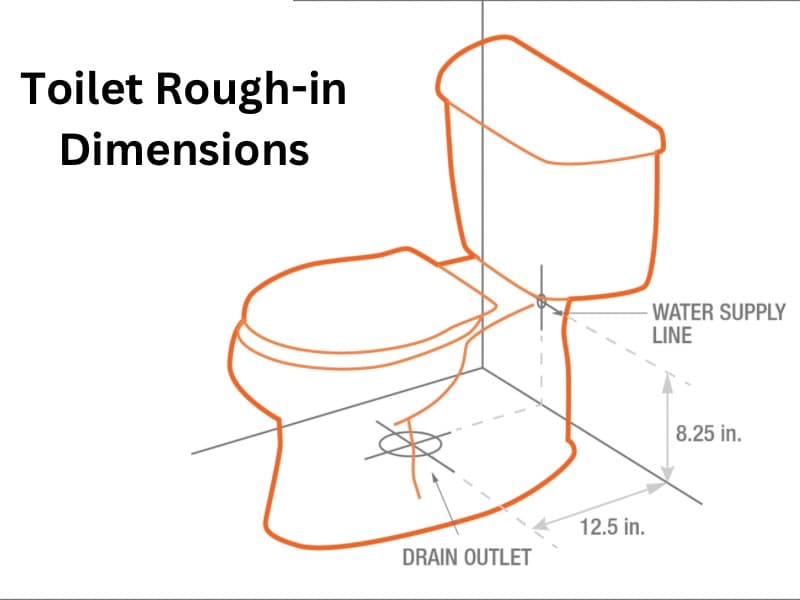Plumbing and electrical rough-in are among the most critical components of a bathroom renovation. Any mistakes or shortcuts will result in the removal of tiles, damage to the walls, and the need to rectify waterproofing. In addition, you’ll need to plan what you want to relocate and where you want to move it, bearing in mind the toilet, sink, shower, and or bath plumbing lines.
The toilet supply line height should be 8¼ inches above the floor. It’s often placed between 5 and 10 inches above the floor. The water supply line is placed 2″ to 3″ higher than the drain pipe for sinks. As for the bathroom, it’s 80″ for the shower, 20 to 22″ for the spout, and 4″ above the tub rim.
Hire a draftsperson or architect to draw out your drawings, which you’ll need before speaking with a builder, tiler, or plumber. You’ll also need to know any applicable state building standards and ordinances, such as minimum distances between sinks and electrical outlets. The article below will help you in your journey.

What are rough-in dimensions?
Rough-in is a broad term that can refer to any trade or activity, although it is most commonly associated with plumbing work in renovation and building. Rough-in refers to the stage of construction when the basic framing has been completed, and the initial services, such as pipes, have been placed but not the end-points such as outlets or fixtures.
Plumbing rough-in means that all water supply and drain pipes have been installed through bored holes in the studs and other frame members, and all pipe connections have been completed. However, no sinks, faucets, or other fixtures or end pieces have been installed.
Plumbing rough-in takes place before the concrete is poured if the house will be built on a concrete slab foundation. This is because waste or drainage pipes are more extensive and have less movement flexibility, and take precedence. After that, the water supply lines are next.
Capped PEX or copper water supply pipes protruding through the floor or wall are expected in a roughed-in bathroom or kitchen. To keep dirt out of drain pipes, they are frequently covered. Before a rough-in plumbing system can be considered complete, it must be pressure-tested.
Rough-In dimensions for sinks, toilets, bathtubs and showers
Remember that not all proportions are set in stone. Instead, think of them as broad recommendations. They will differ depending on the size of your bathroom. For more specific dimensions, see the instructions that came with the fixture (sink, tub, etc.).
| Sink | Toilet | Tub/ shower | |
| Vertical supply line | 2″ to 3″ higher than the drain pipe | 8¼” | 80″ shower, 20 to 22″ spout 4″ above tub rim |
| Horizontal supply line | 4″ to left and right of center | 6″ max. from center | 8″ apart |
| Back wall drain/ discharge hole | N/A | 12½ “ | 14” |
| Vertical drain/ discharge hole | 16” to 20” | 0” | 0” |
| Side to side buffer fixture | 15″ to 20″ min. | 15″ to 18″ min. | 18″ min. |
| Front buffer fixture | 21″ min. | 21″ min. | 18″min. |
Sink rough-in dimensions
The rough-in dimensions for a sink are as follows:
1. Vertical supply line
Two holes, each about 2 to 3 inches above the drainpipe, vertically.
2. Horizontal supply line
One hole is necessary for the hot water supply and the other for the cold water supply. The centerline of one spot is 4 inches to the right, while the centerline of the other hole is 4 inches to the left.
3. Back wall drain/discharge hole
N/A
4. Vertical drain/discharge hole
Consider the drainpipe as the vertical centerline, about 16 to 20 inches above the floor.
5. Side to side buffer fixture
Fifteen inches minimum from the centerline, 20 inches preferable.
6. Front buffer fixture
The minimum distance to the nearest barrier is 21 inches, with a suggested distance of 30 inches.
The sink should be placed about 31 inches above your floor, measured to the rim of your sink.
Toilet rough-in dimensions
The toilet flange is the distance between the bare wall and the center of the toilet drainpipe, is the rough-in size of a toilet. When your toilet is built, a precise rough-in size assures that there will be enough room between the wall and drainpipe for the rear of your toilet and the toilet tank to fit.
The most crucial thing to remember when buying a new toilet is measuring and knowing the exact toilet rough-in.
1. Vertical supply line
The water supply pipe for the toilet should enter the room at 8¼ inches above the floor. This cold-water-only line, in general, creates a hole between 5 and 10 inches above the floor.
2. Horizontal supply line
The water supply line is measured horizontally from the centerline that runs vertically through the toilet’s center. The hole for the water supply line should be 6 inches away from the centerline. Confirm the position of the water supply connection by inspecting the toilet.
3. Back wall drain/discharge hole
Cut a 12 1/2-inch hole on the rear wall.
4. Vertical drain/discharge hole
The drain is at floor level; the distance is zero.
5. Side to side buffer fixture
Minimum clearance to any wall or another fixture is 15 inches measured from the center of the toilet to each side. 18 inches is preferable if the bathroom plan allows it.
6. Front buffer fixture
The minimal clearance to the nearest impediment is 21 inches measured from the front rim of the toilet forward; 30 inches is suggested.
Bathtub/shower rough-in dimensions
Installing the basic elements of a shower is known as roughing-in. The best time to rough in a shower is while the room or home is being built. When you have access to the studs, it’s much easier to install plumbing and shower components.
But, of course, you’ll have to cut through the wall to install the components if you’re doing it after the room has been built.
Bathtubs are typically 5 feet or 60 inches in length. The bathtub, however, may not fit if the rough-in dimension is 60 inches. At the very least, fitting it will be pretty difficult. Regardless, the bathtub will be scrapped.
This is precisely what you don’t want to happen. If you’re replacing a bathtub, you may also need to retile the shower. Fortunately, retiling does not take long.
That’s why, when framing for bathtubs, experts leave a 1/4-inch space. There are a variety of bathtubs available in various sizes.
1. Vertical supply line
The shower arm will be situated 80 inches from the floor. The showerhead will be 65 to 78 inches above the ground level.
2. Horizontal supply line
The height of the faucet valves should be between 20 and 22 inches above the floor. Each faucet should be 4 inches to the right or left of the midline horizontally, and the tub spout is 4 inches above the tub rim.
3. Back wall drain/discharge hole
Place the drain in the middle of the room. The drain access aperture might be from 10 to 14 inches offset from the frame and 6 to 8 inches wide.
4. Vertical drain/discharge hole
The drain is at floor level; the distance is zero.
5. Side to side buffer fixture
A buffer of at least 18 inches is necessary.
6. Front buffer fixture
A buffer of at least 18 inches is necessary.
Conclusion
Before going on to the next stage of construction, the rough-in must be thoroughly examined. This inspection will confirm that everything has been completed following the regulations. The project may now proceed if authorization has been granted.
Using a construction management platform can aid in the seamless completion of the rough-in process. Easily organize subcontractors to maintain efficiency, keeping teams informed about progress and who is required where and when, reducing subcontractor delays, and completing your rough-in on time.
